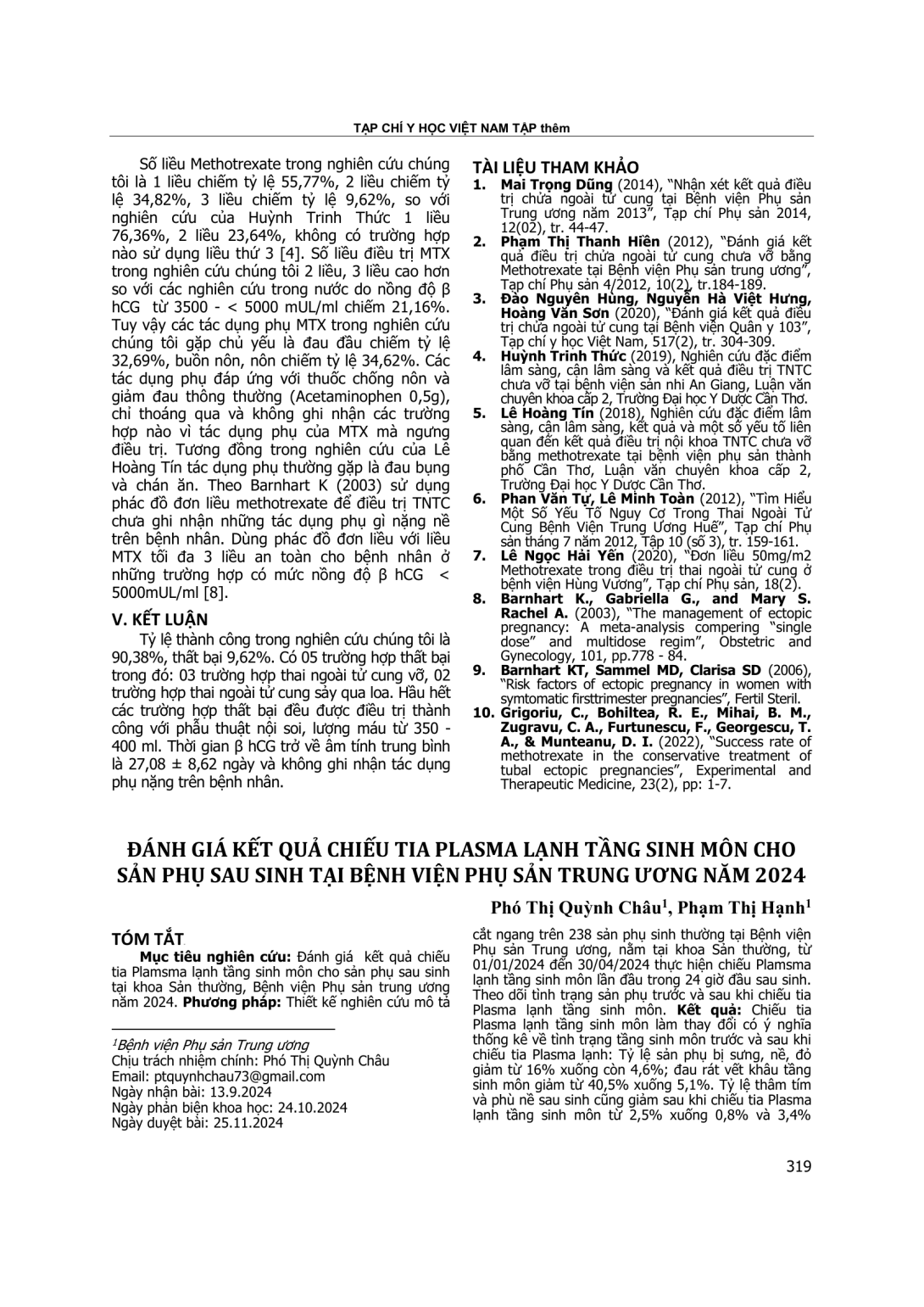
Đánh giá kết quả chiếu tia Plamsma lạnh tầng sinh môn cho sản phụ sau sinh tại khoa Sản thường, Bệnh viện Phụ sản trung ương năm 2024. Phương pháp: Thiết kế nghiên cứu mô tả cắt ngang trên 238 sản phụ sinh thường tại Bệnh viện Phụ sản Trung ương, nằm tại khoa Sản thường, từ 01/01/2024 đến 30/04/2024 thực hiện chiếu Plamsma lạnh tầng sinh môn lần đầu trong 24 giờ đầu sau sinh. Theo dõi tình trạng sản phụ trước và sau khi chiếu tia Plasma lạnh tầng sinh môn. Kết quả: Chiếu tia Plasma lạnh tầng sinh môn làm thay đổi có ý nghĩa thống kê về tình trạng tầng sinh môn trước và sau khi chiếu tia Plasma lạnh: Tỷ lệ sản phụ bị sưng, nề, đỏ giảm từ 16% xuống còn 4,6%; đau rát vết khâu tầng sinh môn giảm từ 40,5% xuống 5,1%. Tỷ lệ thâm tím và phù nề sau sinh cũng giảm sau khi chiếu tia Plasma lạnh tầng sinh môn từ 2,5% xuống 0,8% và 3,4% xuống 1,7%. Đa số các sản phụ rất hài lòng về dịch vụ chiếu tia Plasma lạnh tầng sinh môn tại khoa Sản thường: trang thiết bị (86,1%); thái độ phục vụ (87,4%) và kỹ thuật (89,1%). Kết luận: Chiếu tia Plasma lạnh tầng sinh môn làm thay đổi có ý nghĩa thống kê về tình trạng tầng sinh môn, tình trạng đau vết khâu tầng sinh môn trước và sau khi chiếu tia Plasma lạnh tầng sinh môn. Đa số các sản phụ rất hài lòng về dịch vụ chiếu tia Plasma lạnh tầng sinh môn tại viện.
The evaluation of cold plasma irradiation results for postpartum women at the National Obstetrics and Gynecology Hospital in 2024. Subjects and methods: A cross-sectional descriptive study was conducted on 238 mothers who had normal deliveries at the National Hospital of Obstetrics and Gynecology from January 1, 2024, to April 30, 2024. Cold plasma irradiation was applied within the first 24 hours postpartum. The condition of the mothers was monitored before and after the irradiation. Results: Cold plasma irradiation significantly changed the condition of the perineum before and after irradiation. The rate of perineal tearing decreased from 16% to 4.6%; the rate of pain at the suture site decreased from 40.5% to 5.1%. The rate of bruising and swelling after childbirth also decreased after cold plasma irradiation, from 2.5% to 0.8% and from 3.4% to 1.7%, respectively. Most women were very satisfied with the cold plasma perineal irradiation service at the obstetrics department: equipment (86.1%); service attitude (87.4%); and technique (89.1%). Conclusion: Cold plasma irradiation significantly changes the statistical condition of the perineum, pain condition, and the ability of perineal regeneration before and after cold plasma irradiation treatment. The majority of patients are very satisfied with the cold plasma irradiation service at the hospital.
- Đăng nhập để gửi ý kiến
